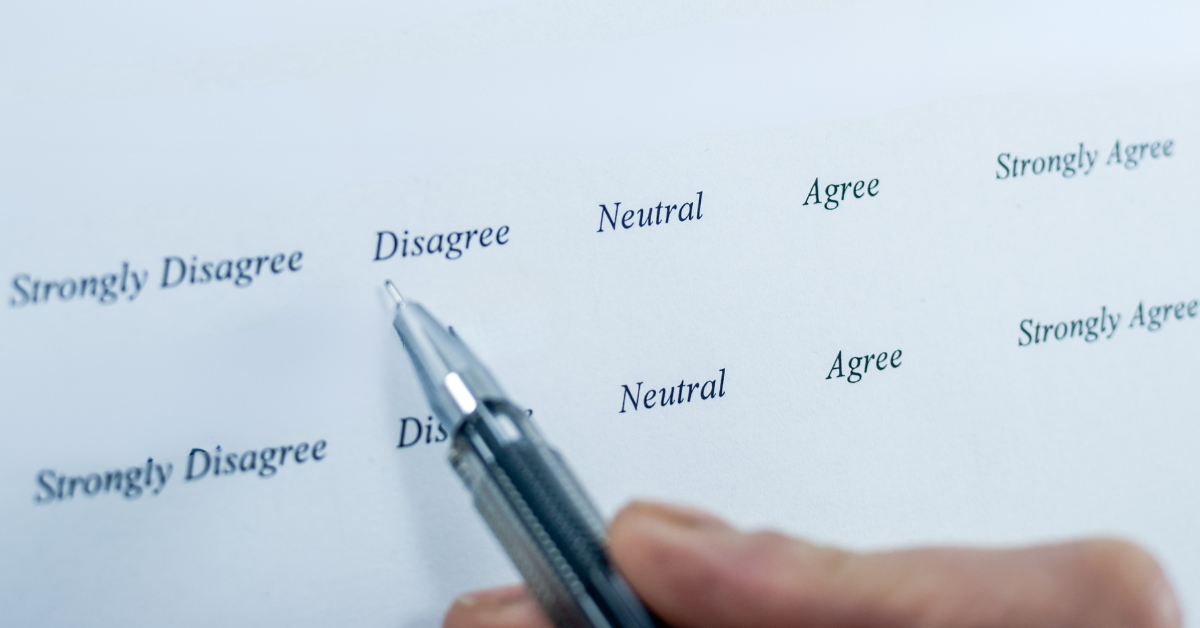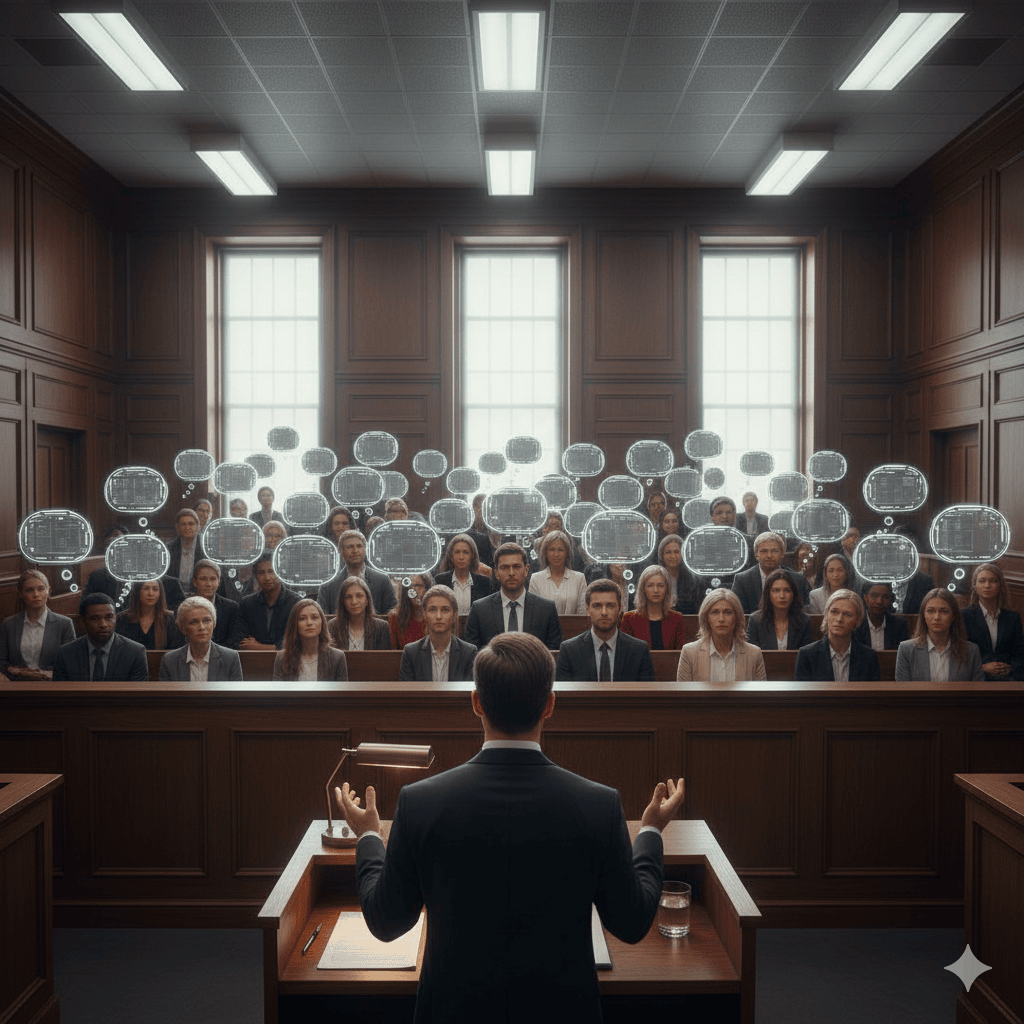Voir dire is often one of the most underleveraged tools in the defense arsenal. Yet it’s one of the few opportunities defense counsel has to shape the jury before opening statements begin. When it comes to voir dire questioning strategies, this phase is often approached with outdated tactics like yes and no hand-raises, vague hypotheticals, or demographic profiling. If you’re not getting meaningful data from voir dire, it’s not the jurors – it’s your questioning strategy.
The best approach isn’t theoretical. It’s built from real-world defense work, rooted in behavioral science, and refined through hundreds of mock trials and live jury selections.
How do Likert scales improve jury questionnaires?
A structured, multi-point range (from strongly disagree to agree) captures nuanced juror attitudes better than binary yes and no responses. Likert scales provide clearer, more actionable data, especially when modified to exclude neutral options that often yield noncommittal answers.
The Problem with Dichotomous Questions
The traditional approach, “Raise your hand if you distrust corporations,” is not just simplistic. It’s flawed. It pressures jurors into binary answers and fails to capture the nuance of their beliefs. Worse, it often suppresses disclosure where jurors with strong opinions may remain silent to avoid standing out.
Yes/no questions shut jurors down when you need to open them up. Instead of forcing a binary response, the most effective voir dire questioning strategies are structured to elicit graded, authentic, and actionable feedback.
Replace Yes/No with 0 to 10 Scales
One of the most effective oral voir dire techniques involves asking jurors to rate their belief or attitude on a 0–10 scale. For example:
“To what extent do you distrust large corporations? Zero means you have no distrust. Ten means total distrust. Juror #1, what’s your number?”
This structure offers granularity, where jurors have more response options instead of just 2, and reduced social pressure. Voting a number is less confrontational than raising a hand to make a finite statement, such as, “I distrust corporations.” A scale provides more useful data; attorneys can track intensity (numerical rating) and reasoning (explanation).
Get to the “Why?”
The number is just the start. What matters most is the rationale behind it. After a juror gives their number, follow up with a single sentence prompt (open-ended questions):
“In one sentence, what’s the main reason behind that number?”
This encourages concise, focused explanations and gives you a window into the juror’s belief system. An angry juror or one who rates corporate distrust as a 9 because of a personal experience is different from one influenced by media or ideology. And, both are strikes for different reasons.
Positively Reinforce Negative Responses
The defense benefits from negative juror attitudes to challenge for cause or deprioritize them in strikes. But jurors are largely unaware of that. That’s why reinforcement matters for voir dire questioning strategies.
When a juror says, “9.9 – I think corporations are greedy and dangerous,” don’t recoil or argue. Do the opposite:
“Thank you for that. I appreciate your honesty.”
This subtle reinforcement (a principle from operant conditioning) tells the room it’s safe to speak candidly. If you signal discomfort or judgment, you’ll shut the rest of the panel down.
Remove the Neutral Option on Questionnaires
In supplemental juror questionnaires, use modified Likert scales but with a twist. Most Likert items run from “strongly disagree” to “strongly agree,” with a neutral midpoint. Lose the neutral.
Why? Because jurors flock to it. “Neutral” is a non-answer. A four-point scale (Strongly Disagree, Disagree, Agree, Strongly Agree) forces movement and yields more precise data.
Example: Corporate America puts profits over safety.
[ ] Strongly Disagree
[ ] Disagree
[ ] Agree
[ ] Strongly Agree
Then follow with:
“What is the main reason for your response?”
This dual-format strategy includes a quantitative and qualitative approach and is invaluable in pretrial profiling.
Adapt for Time-Constrained Voir Dire
In federal court or other situations with limited time, you may not have the luxury to go juror-by-juror. In that case, you can still use the scale method, but group it.
“On a 0 to 10 scale, how much do you distrust large corporations? If you’re in the 1–3 range, raise your hand. Now 4–6. Now 7–10.”
Then target a few representatives from each group to elaborate on their responses. It’s not ideal, but it preserves the structure while saving time.
Use Focus Groups and Mock Trials to Test Questions
Voir dire isn’t just about trial day. Use pretrial research to refine your approach. Focus groups and mock trials are excellent forums to test question phrasing, scale comprehension, and juror openness. Incorporate the 0–10 questioning model into your debriefs. Ask questions like, “What made you rate it a 7?”, “Was there anything that would have pushed you lower or higher?” These help fine-tune your language and anticipate juror hesitations during trial.
Don’t Just Ask Better Questions, Set Them Up Better
The question is only 10% of the battle. The setup and follow-through matter more. Jurors need clear instructions, time to think, and reinforcement that it’s safe to speak. Good voir dire questioning strategies minimize pressure and judgment, give jurors options beyond black-and-white, use behavioral cues to encourage candor, and deliberately apply operant conditioning (positive reinforcement).
A Better Voir Dire Strategy with Courtroom Sciences
Defense attorneys can’t afford to waste voir dire on superficial rapport-building. The right questioning strategies can give deep insight into juror psychology. Better voir dire questioning is about more than phrasing. It’s about understanding juror behavior, shaping the group dynamic, and getting to the truth.
Courtroom Sciences helps attorneys efficiently navigate litigation by providing psychological expertise, science-backed data, and expert support for all phases of litigation. Learn how CSI’s litigation consulting experts can improve outcomes for your next case.
Speak with one of our experts to get started.
Be confident in achieving superior litigation outcomes. CSI has the expertise, track record, and capabilities to help you win.



